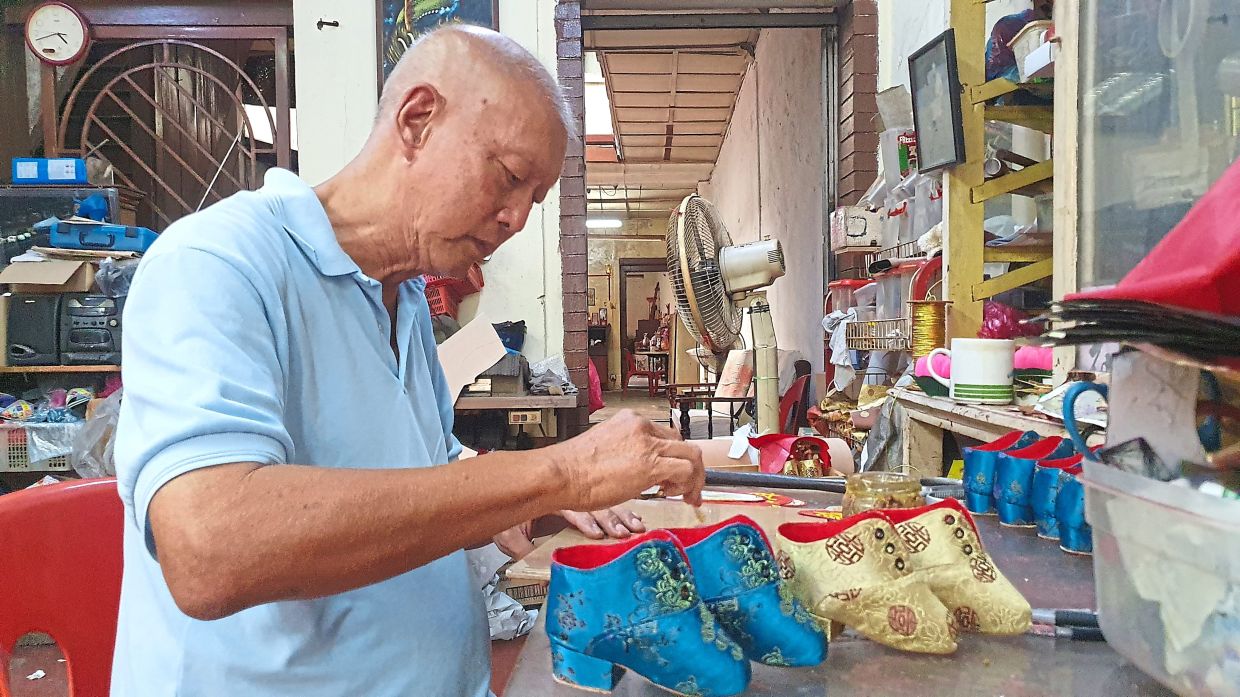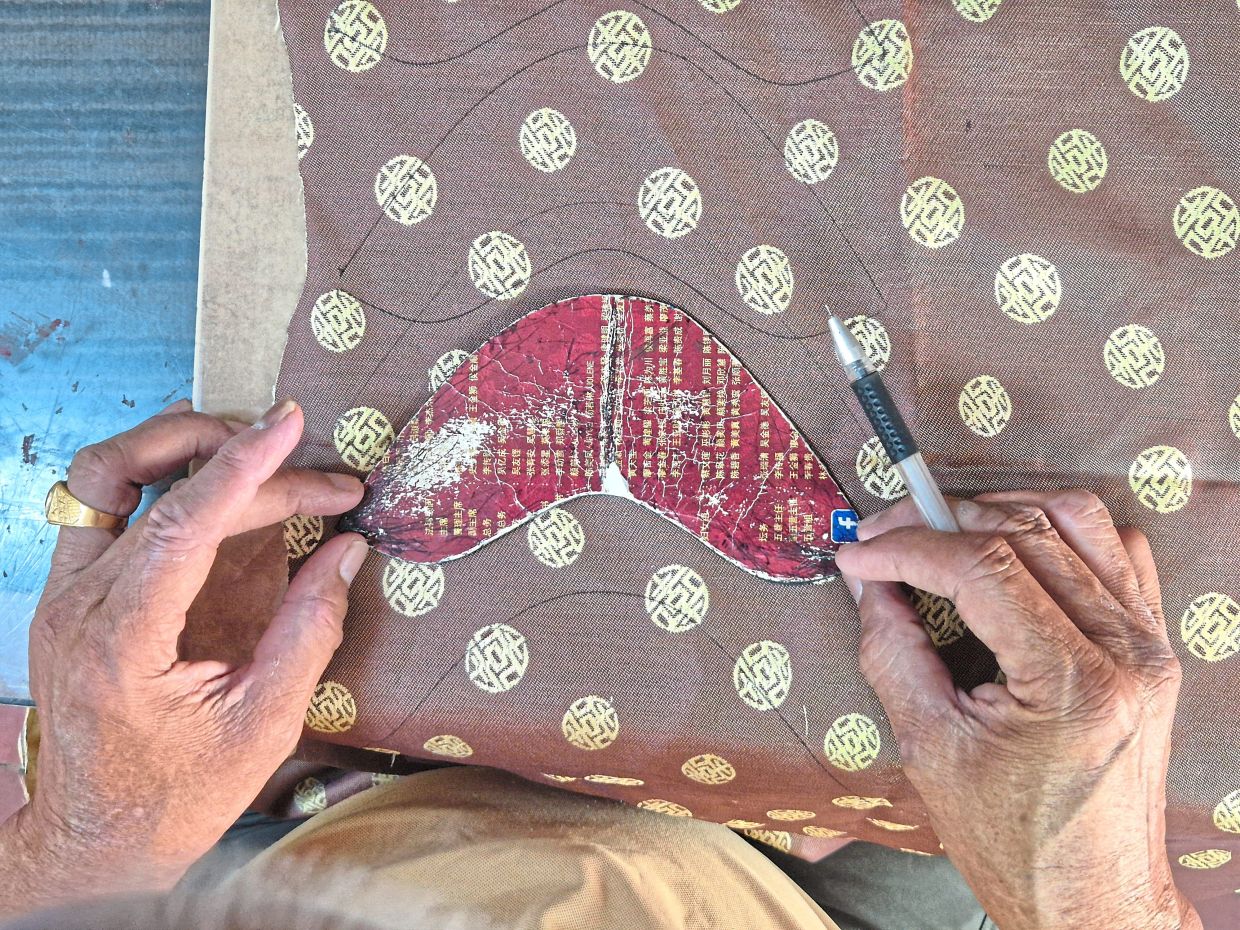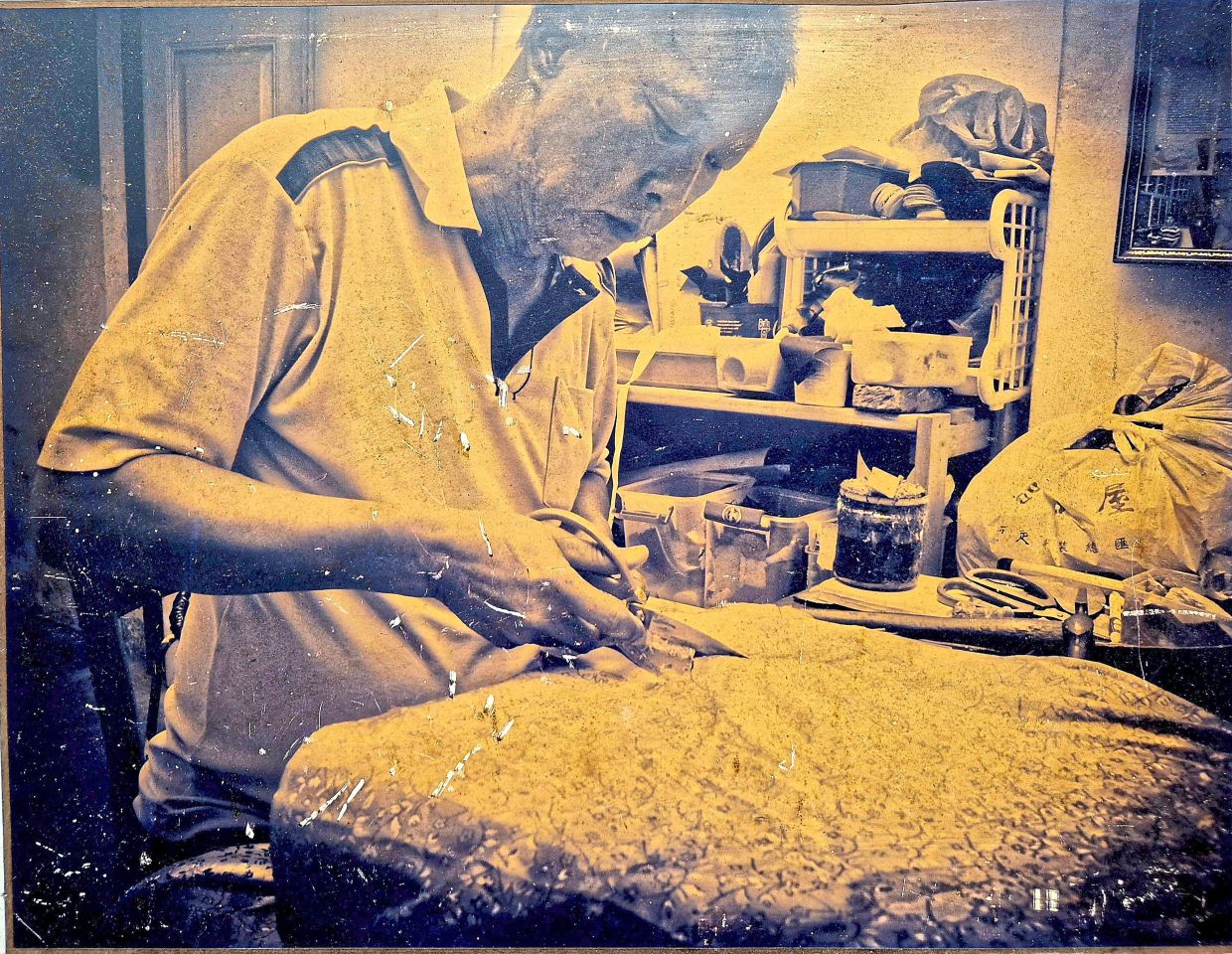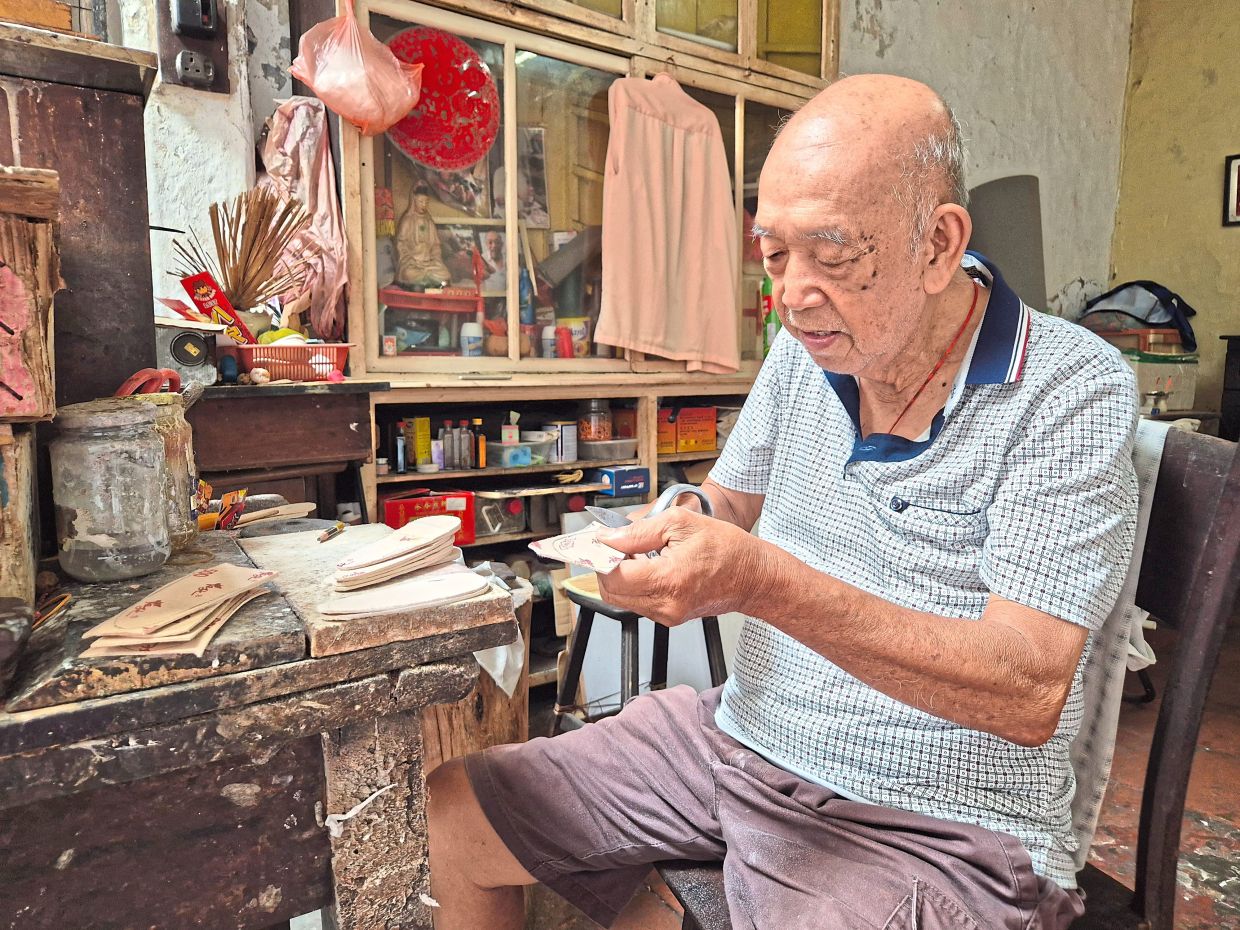Raymond holds a pair of bound feet shoes which pays tribute to his family’s heritage and a bygone era. Photos: The Star/Sheela Chandran
Stepping into the Yeo family’s shop in Melaka feels like a journey back to the 1960s. The space is simple and unpretentious, with no air-conditioning, the whirring sound of fans and the scent of leather and glue filling the air.
Aged wooden cabinets line the walls, their drawers filled with materials like satin-weave silk brocade fabric, leather and beads.
In the shop is Tony Yeo, 86, who is proud to be one of the few remaining artisans in the country skilled in the intricate craft of making bound feet shoes.
Together with his brothers Simon, 76, and Raymond, 72, these craftsmen aim to continue making these ancient shoes, measuring just three inches (7.6cm) in length, for as long as possible.
“If we stop making these shoes, how will people remember our past? Not many children today even know what bound feet shoes are,” says Tony during an interview in the historical city.
The Yeo brothers are the third-generation owners of Wah Aik, a business specialising in crafting bound feet shoes and kasut manik (beaded shoes), popular among Peranakan women. Their grandfather, Yeo Eng Tong, founded the business in 1920, and they take pride in continuing the family legacy, which is over a century old.
Though Tony and his siblings are well past retirement age, they are not quite ready to hang up their shoes yet.
“I have been making bound feet shoes since I was in primary school. All of us would gather at my Ah Gung’s (grandfather) shop to help with the orders for kasut manik and bound feet shoes,” says the soft-spoken bachelor as he hunches over his tools to carve the insoles for the shoes.
Foot-binding was a practice that began in 10th-century China imposed on women as a symbol of status and beauty. At the time, having bound feet increased a woman’s chances of marrying into a wealthy family.
The process involved tightly binding the feet with cloth – breaking the toes and arch – then wrapping them with bandages to hold the feet in a painfully curved position. This prevented further growth, forcing the foot into a pronounced arch and creating the prized small, delicate appearance.
Such bound feet were known as golden lotuses.
While foot-binding was a custom rooted in China, some Chinese immigrant women in Malaya also had bound feet, carrying the tradition with them across the seas.
They required specially crafted shoes – often made from silk and intricate embroidery – to fit their deformed feet.
Although the practice was banned in China in 1912, Tony’s grandfather continued to make these shoes for customers who needed them due to their bound feet.
“Women with bound feet still required these shoes because their feet had been permanently deformed. Even after they removed the bindings and allowed their feet to grow,
custom-made shoes were necessary to accommodate their altered shape.
“The last time we made a pair was in the 1990s for a customer from Sekinchan, Selangor,” shares Raymond.
So why continue making bound feet shoes when there’s little demand for them?
For Raymond, it is about preserving history and his family’s legacy.
“These handmade shoes are popular among tourists and collectors, who buy them as cultural artefacts. In a week, we can sell around two to six pairs of bound feet shoes. Most of our customers are from Europe, mainly France, and Britain,” says Raymond, flipping through guestbooks from as far back as the 1980s filled with comments from customers.
While the three brothers run the shop and craft the shoes, their sister, Yeo Soon Lan, 54, handstitches beads onto pairs of kasut manik.
“We receive about four to five orders a month for beaded shoes. Some customers prefer ready-made pairs so we always have extra pairs in our store,” says Simon, adding that a significant portion of their business comes from both making new beaded shoes and repairing old ones.
The price for a new pair of kasut manik starts from RM700. Repair work can cost anywhere from RM500 to RM900.
In one corner, an over 100-year-old Singer sewing machine, once used by their grandfather, still stitches together these delicate footwear.
“If this sewing machine could talk, it would surely have countless stories to tell,” Simon quips.
The brothers learned their craft from their late father, who in turn inherited the skills from his grandfather. From what they recall, their grandfather was born in Hainan, China, and he could have learned to make bound feet shoes before arriving in Malaya in the late 19th century.
Artisanal touch
The bound feet shoes are entirely handmade, taking about a week to complete. The cost of making a pair is RM95.
Each shoe comprises several key parts: the heel, often stiff and raised; the sole, made from leather; the toe box, made from soft cardboard to accommodate the bound foot; and the cloth.
“The shoes are made exactly as how our grandfather once crafted them. They can still be worn by a woman with bound feet,” Simon assures.
He adds that the preferred colours for the satin material are pink, black, gold and red.
“Popular prints often feature floral designs, like peonies and lotuses, as they symbolise beauty and prosperity. We travel to Petaling Street in Kuala Lumpur every three months to buy the materials. Although we have tried sourcing them online, the quality can sometimes be inconsistent, so we prefer to make the trip ourselves. As for the leather, we purchase it from suppliers in KL, while the leather is imported from India,” says Simon.
Tony works at the back of the shop, smoothing the edges of the leather soles and polishing the wooden heels, made from rubber wood sourced from a sawmill in Melaka.
Simon is responsible for crafting the toe box. He starts by tracing a standard curved pattern onto materials like satin, velvet and soft cardboard.
After cutting out the shapes, Simon uses solvent glue to secure the layers – starting with satin on top, followed by soft cardboard and velvet cloth.
Next, Tony attaches the toe box to the sole, which is left to dry for several days. When everything is assembled, Simon glues the base of the heel and reinforces it with small flat-head nails.
Judging by their expertise, the brothers are undoubtedly masters of their craft. But what’s worrying is that none of their relatives are interested in learning the trade, and the brothers themselves aren’t keen on organising classes to pass it on.
The future of this rare craft, therefore, remains uncertain.
“Both Raymond and Tony are bachelors, and my only daughter isn’t interested in learning the art,” says Simon, with a shrug.
“It takes about a week to make these handcrafted shoes, and we only charge RM95 for all that work. You need patience and genuine interest to learn this. It’s not something you can pick up easily,” he adds.
Or could it be that people aren’t interested in learning this craft because it is associated with the painful and oppressive practice of foot-binding?
Whatever the reason, only time will tell if this heritage craft will be passed on in the future, or disappear for good.
Stepping back in time
Raymond holds a pair of bound feet shoes which pays tribute to his family’s heritage and a bygone era. Photos: The Star/Sheela Chandran
Tony has been making bound feet shoes since he was in primary school.
Photo: The Star/Sheela Chandran
Most of their customers are from Europe and Britain, says Raymond (left).
Photo: The Star/Sheela Chandran
The insoles of bound feet shoes, measuring just 7.6cm.
Photo: The Star/Sheela Chandran
From left: Raymond, Tony and Simon are proud to carry on their family’s heritage of crafting bound feet shoes.
Photo: The Star/Sheela Chandran
A standard cut-out is used to trace the sizing onto material to create the bound feet toe box.
Photo: The Star/Sheela Chandran
The shoes are made exactly as how his grandfather once crafted them, says Simon.
Photo: The Star/Sheela Chandran
An assortment of finished bound feet shoes, each no longer than a handspan.
Photo: The Star/Sheela Chandran
Simon has been making bound feet shoes for over six decades.
Photo: The Star/Sheela Chandran
A standard cut-out is used to trace the sizing onto material to create the bound feet toe box.
Photo: The Star/Sheela Chandran
















